15.1 Weathering Rocks
Distinguish between physical weathering and chemical weathering and provide examples of each.
They say nothing lasts forever. This adage is certainly true of Earth’s physical surface. Even the mightiest and most massive mountains are ephemeral features in the great span of geologic time. In Part III, we examined the work of Earth’s geothermal energy in building Earth’s surface and creating vertical relief. In Part IV, we explore how these uplifted landforms are torn down. The Sun evaporates water that precipitates back down on the continents, and gravity sets that water in motion. The Sun also creates differences in atmospheric pressure, and these differences drive the wind and ocean waves. Streams, flowing glaciers, wind, and coastal waves carve into Earth’s uplifted surface. Therefore, solar energy drives erosion of the crust’s surface.
Tectonic forces act sporadically across Earth’s surface, but the forces that reduce vertical relief are present nearly everywhere on land and never rest. Weathering is the process by which solid rock is dissolved and broken apart into smaller fragments.Erosion is the transportation of rock fragments by moving water, ice, or air. Weathering, erosion, and deposition of rock material are all processes of denudation: the lowering and wearing away of Earth’s surface.
weathering
The process by which solid rock is dissolved and broken apart into smaller fragments.
erosion
The transport of rock fragments by moving water, ice, or air.
denudation
The lowering and wearing away of Earth’s surface.
Denudation begins with the disintegration of rock into smaller and smaller fragments. The forces of weathering may physically break rocks apart or decompose them through chemical reactions with water. Unweathered, or “fresh,” rock surfaces are either newly formed or newly exposed. Eventually, all rocks exposed at Earth’s surface will weather, either through physical weathering or chemical weathering.
Physical Weathering
Physical weathering breaks rocks down into smaller pieces, or clasts—
physical weathering
The breakdown of rocks into smaller pieces, or clasts, without altering the chemical makeup of the rock.
Natural cracks in rock, called joints, provide surface areas on which physical weathering processes can act. Nearly all outcrops have joints. Tectonic stresses near geologic faults commonly fracture rocks and create jointing. Igneous rocks become jointed as the rock cools and changes shape slightly. Sedimentary rocks usually have horizontal joints at their bedding planes (the surfaces where their layers meet), but sedimentary rocks also form vertical jointing as a result of stresses on the rock, as shown in Figure 15.2.
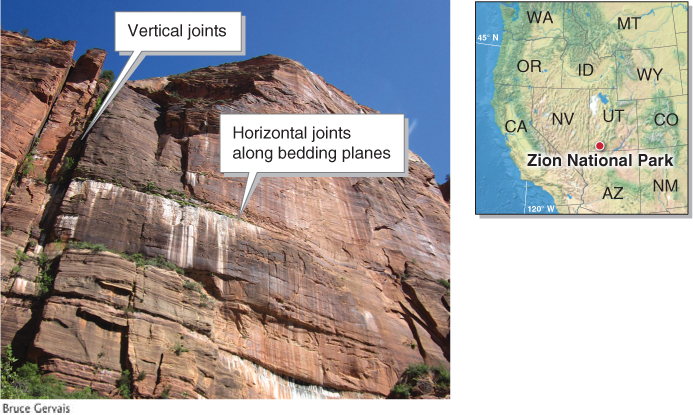
Pressure-
Exfoliation, a type of pressure-
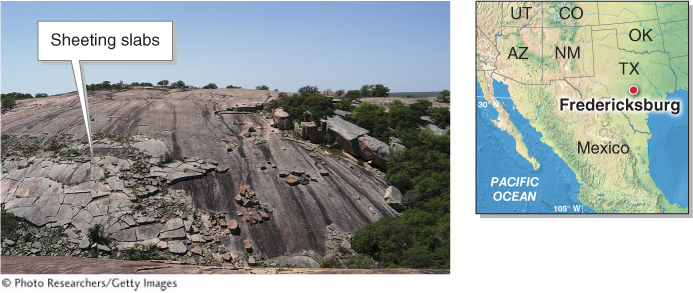
exfoliation
A physical weathering process in which joints form parallel to a rock surface, creating sheetlike slabs of rock.
Where temperatures routinely drop below freezing, frost wedging is the most important type of physical weathering. Frost wedging is the process by which water trapped in an opening in a rock freezes and expands, causing the opening to grow. When liquid water freezes to ice, it expands by almost 10%. If water freezes in a confined space, such as a water pipe in a house, a glass bottle in the freezer, or a joint in a rock, it applies considerable force as it expands against the material confining it. Repeated freezing and thawing of water in rock joints pries the rocks apart over time, as shown in Figure 15.4.
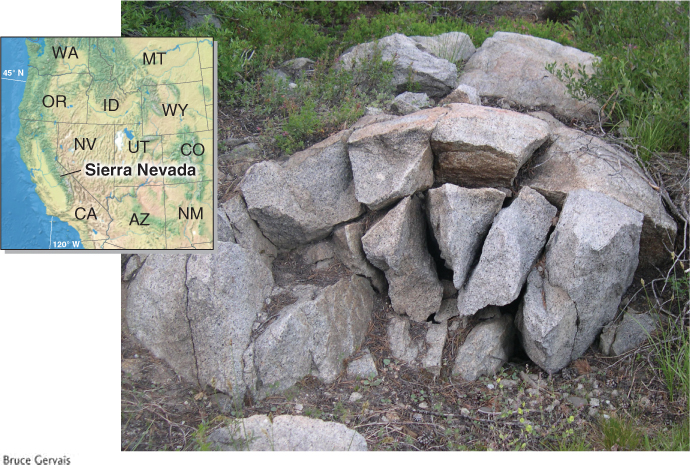
frost wedging
A physical weathering process in which water trapped in an opening in a rock freezes and expands, causing the opening to grow.
Salt wedging is a process in which salt crystals grow in pore spaces on a rock’s surface and dislodge individual mineral grains within the rock. Salt wedging weakens rock so that wind and rain can further disintegrate it. Salt crystal growth requires that the rock surface be continually wetted, then dried. Salt wedging occurs mostly in arid climates where evaporation is high and in coastal areas where rocks are coated with salt spray from waves. Tafoni are rounded pits or cavities on the surface of a rock that form through salt wedging. They are most common in coastal regions (Figure 15.5).
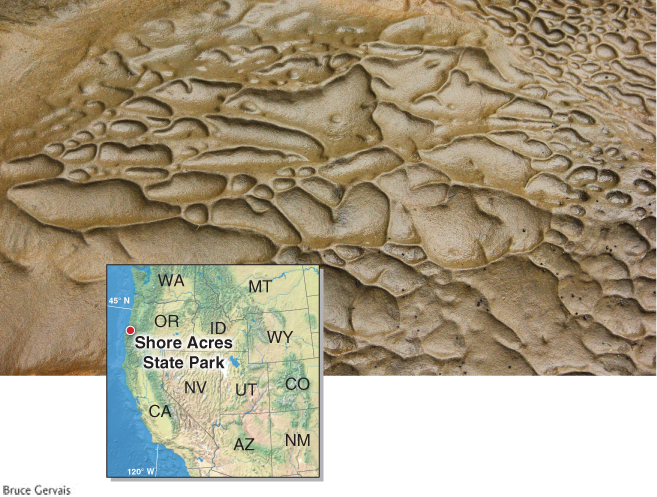
salt wedging
A physical weathering process in which salt crystals grow in pore spaces on a rock’s surface and dislodge individual mineral grains within the rock.
tafoni
Pits or cavities on the surface of a rock that form through salt wedging.
Biophysical weathering refers to weathering by any living organism. Animals from small rodents to massive elephants can physically break rock down into smaller pieces. Root wedging occurs when plant roots grow into joints seeking water. Many city residents have seen sidewalks buckled by tree roots as they push up from below. The same thing happens in natural settings: As roots grow, they force rocks apart (Figure 15.6).
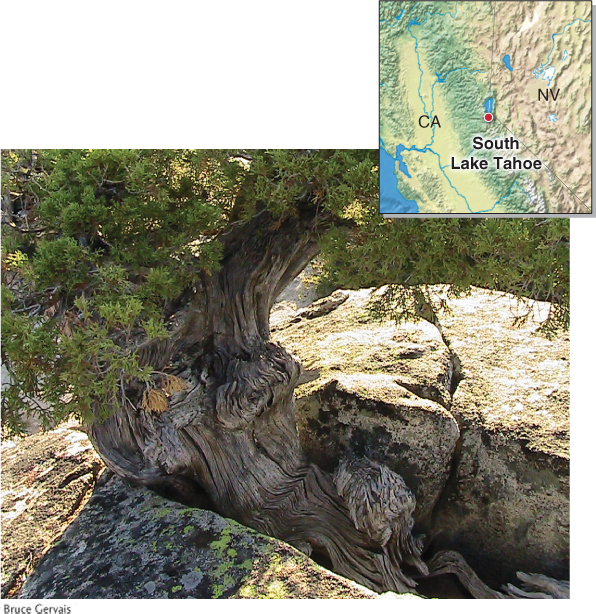
root wedging
A physical weathering process in which plant roots break rocks apart.
Chemical Weathering
Physical weathering breaks rock apart without altering its chemical structure. Chemical weathering, in contrast, changes the minerals in rock through chemical reactions involving water. Physical and chemical weathering both occur at the same time and affect each other’s rates. For example, because chemical weathering occurs mainly on the surfaces of rocks, physical weathering assists in the process of chemical weathering by breaking rocks into smaller pieces and creating a greater surface area on which chemical weathering can act (Figure 15.7).

chemical weathering
A process that changes the minerals in a rock through chemical reactions involving water.
Chemical weathering is dominant where temperatures are above freezing and there is ample moisture. As a result, rocks in the lowland tropics are most altered by chemical weathering.
A number of chemical reactions can result in chemical weathering. One such reaction is carbonation, which results when carbon dioxide dissolves in water, forming carbonic acid (H2CO3). Carbonic acid reacts with carbonate rocks such as limestone. As limestone is weathered through carbonation, rainwater carries away the dissolved material in a carbonic acid solution. Section 15.2 describes some of the topographic results of this process.
Hydrolysis occurs when water reacts with and combines with minerals in rocks to form new minerals. Typically, the new minerals are softer and more easily eroded than the original minerals. Silicate minerals, such as those found in granite, are particularly susceptible to hydrolysis.
Similarly, during hydration, water is added onto minerals in rock or soil, causing the material to expand and weaken. Hydration changes the texture, composition, and volume of minerals in rocks. Clay, for instance, softens through hydration as it absorbs water. One type of clay, called bentonite, can increase in volume by 1,600% through hydration. Similarly, hydration of the mineral anhydrite forms gypsum.
In oxidation, oxygen atoms combine with the minerals in rocks and weaken them. Just as iron rusts, rock containing iron-
Biochemical weathering refers to chemical weathering resulting from the activities of living organisms. Many plant roots, bacteria, lichens, and fungi obtain nutrients by producing acids that break down minerals in rocks.
Differential Weathering
Weathering does not occur equally across the surface of a rock. Angular blocks, for example, experience the most weathering along their edges and corners. This pattern of weathering leads to the formation of rounded or spheroidal boulders, as illustrated in Figure 15.8.
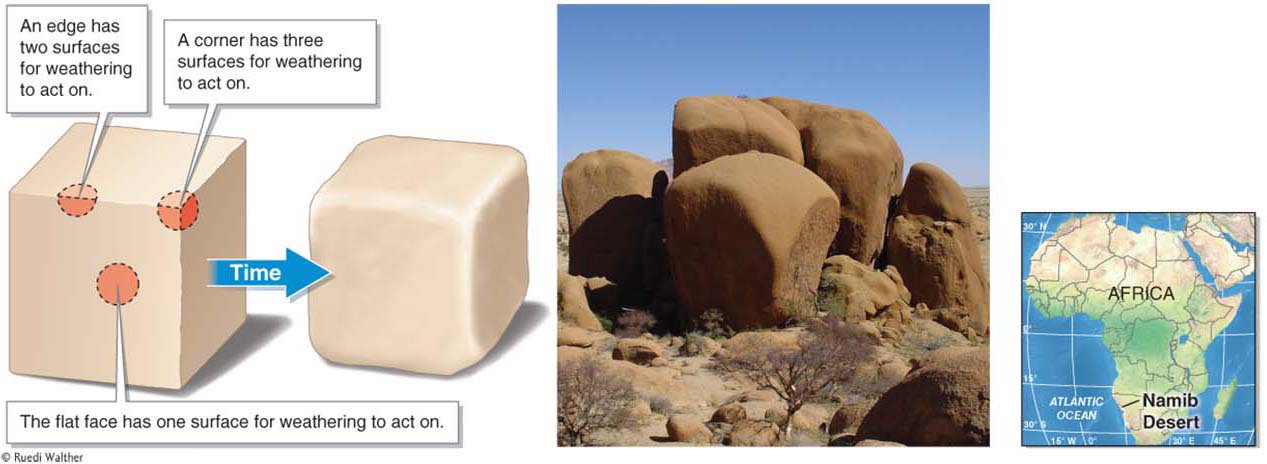
Picture This
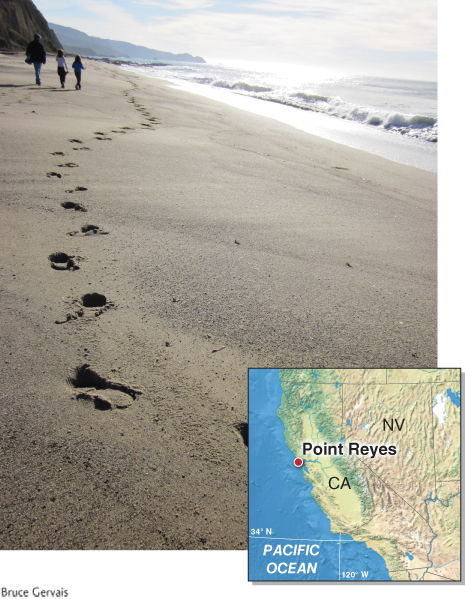
The Life of a Sand Grain
One of the minerals most resistant to weathering is quartz, a mineral found in many rocks. Many minerals in rocks are subject to chemical weathering, particularly oxidation and hydrolysis. Quartz, however, is extremely resistant to chemical weathering and may persist for millions of years as grains of quartz sand.
Many beaches of the world are made up in large part of quartz sand grains that were long ago weathered out of bedrock. An individual sand grain on the beach might have been weathered from granite high on a mountain range long ago. From there, it might have been transported to a beach, where the waves washed over it for millennia. This ancient beach sand could then have been lithified to form new sedimentary rock, only to be uplifted by geologic forces into a different mountain range, with our quartz grain in it. Eventually, weathering might have torn this mountain range down, too, creating a new beach many millions of years later. This process could have been repeated several times through hundreds of millions of years.
Question 15.1
Where does beach sand come from?
The sand grains that make up most beaches are the weathered and eroded remnants of bedrock that once formed mountains.
Each grain of sand on a beach is a product of Earth’s deep geologic history. In this sense, when we walk across a beach, such as this one on the shoreline of Point Reyes in northern California, we also walk across a portion of Earth’s ancient history.
Consider This
Question 15.2
How does differential weathering result in a beach composed of quartz sand?
Question 15.3
How can quartz grains be older than the bedrock from which they come?
Weathering that occurs at different rates across a rock surface is called differential weathering. As Figure 15.9 shows, differential weathering also results when rocks of different types occur within a body of rock, sometimes creating dramatic or unusual landforms.
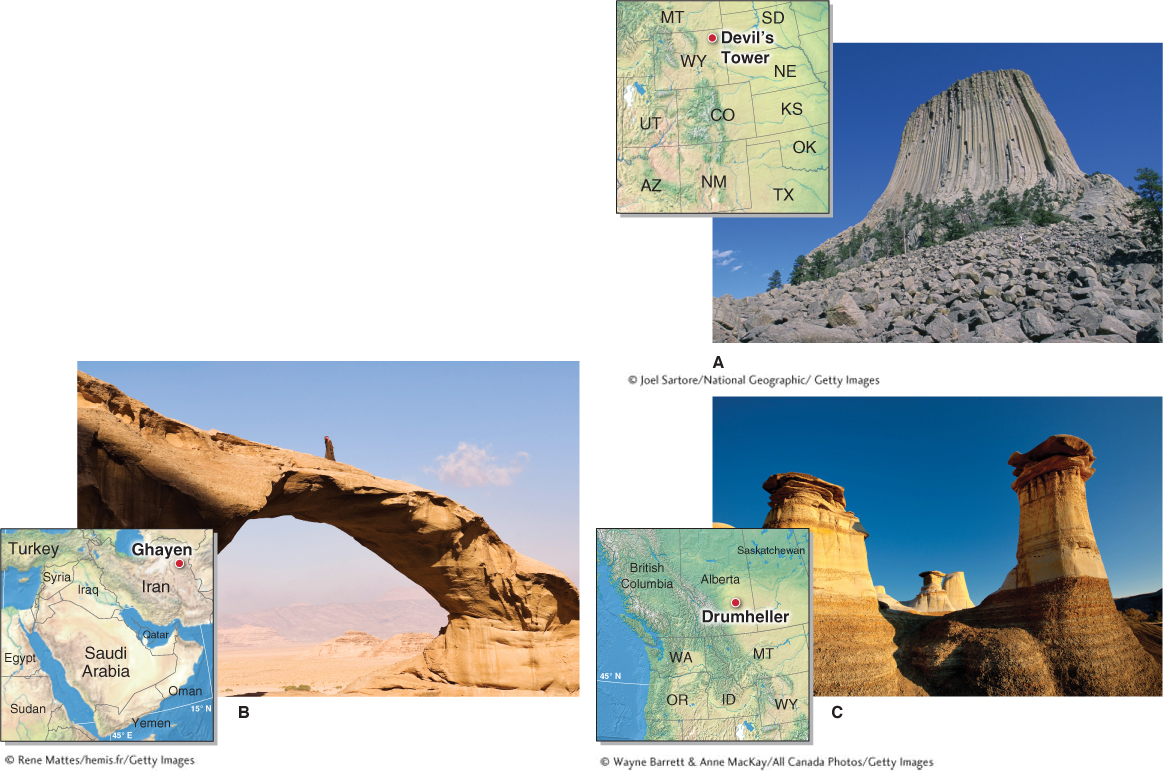
differential weathering
Unequal weathering across a rock surface.
Weathering also acts on weaker minerals within rocks more than on relatively resistant minerals. As a result, resistant minerals, such as quartz, persist through time, while weaker minerals are broken down. Many beaches are composed of resistant quartz grains that were once embedded within rocks, as Picture This discusses.
